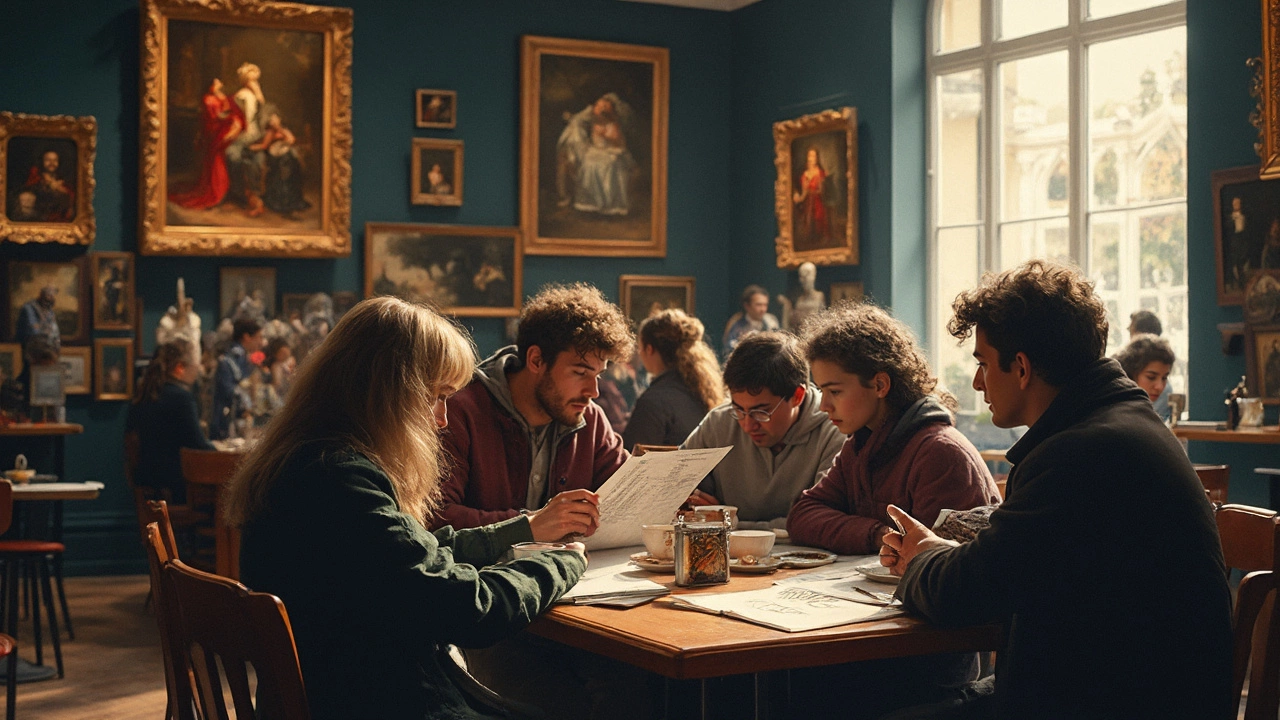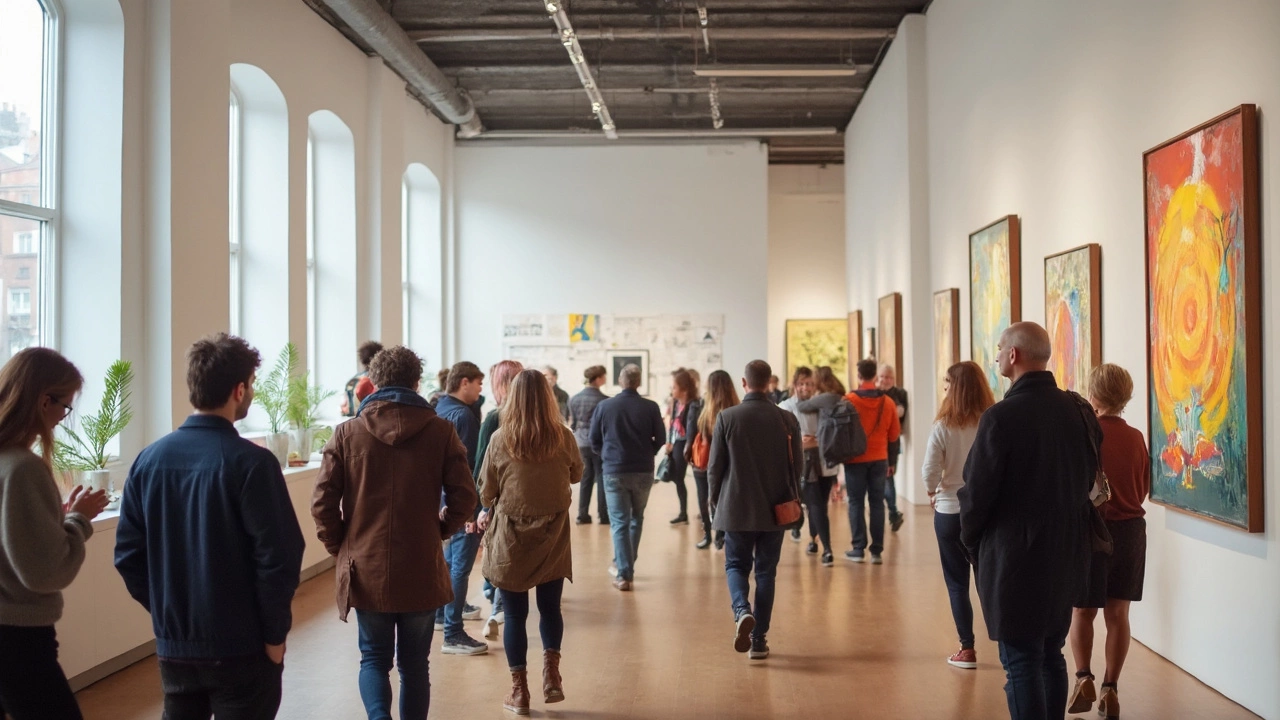If you think art exhibitions are just for the pretentious or the bored, you might be missing out. There’s something electric about standing in front of a canvas, way different from swiping through digital images. Originals show you textures, wild brushstrokes, and colors screens just can’t catch. People often talk about getting chills or seeing details they’d never notice in a photo.
And here’s the kicker: museums and galleries pull in everyone from kids on field trips to retired engineers, not just artists or critics. These spaces give you a chance to see how people in other eras or cultures tackled big ideas—sometimes just by staring at a picture. Plus, exhibitions aren’t just about old masters. Loads of places focus on street art, digital art, or wild installations, so there’s usually something that matches your vibe.
- Beyond Instagram: The Magic of Seeing Art in Person
- How Exhibitions Recharge Your Mind and Creativity
- Why It’s a Social Thing—Not Just for Art Nerds
- Tips to Get the Most Out of Your Next Gallery Visit
Beyond Instagram: The Magic of Seeing Art in Person
Scrolling through your feed, you see art everywhere—famous paintings, wild street murals, or some colorful modern thing everyone’s reposting. But here’s the thing: seeing art exhibitions in the flesh just hits differently. Research from the University of London found that people who looked at famous paintings in person reported increased levels of joy and lower stress compared to those who viewed the same works on a screen. The brain actually lights up more when you see real-life colors and textures up close.
When you’re standing in front of a real artwork, your eyes pick up details a phone camera blurs out—the thickness of the paint, the dents on a metal sculpture, sometimes even little mistakes or hidden symbols the artist left behind. Impressionist paintings are a perfect example: up close, you can see wild brush marks that seem random, but a few steps back, the whole scene snaps into focus. No Instagram filter can swing that trick.
It’s not just about close looks, though. The size of the piece totally changes how you feel. Walk into a room with a giant canvas by Mark Rothko or a huge installation, and you get surrounded by color and shape. For some, that’s a straight-up emotional experience. Gallery lighting matters, too—it’s set up to show art at its best, not like some weird glare you get off your phone screen.
There’s also the whole vibe of the space. Seeing people react, the quiet or the buzz of a busy show, it all adds to how you feel about the art. Even kids pick up on this—the Louvre in Paris reported that in-person art viewing is linked to better attention spans among young visitors. You’re just more present and engaged than you would be flicking through photos at home.
| Fact | In Person | On Screen |
|---|---|---|
| Joy level (avg, scale 1-10) | 8.1 | 5.6 |
| Details visible | High (brushstrokes, texture) | Low (flattened) |
| Size perception | True to actual | Distorted |
So, if you’ve ever felt underwhelmed by a famous painting online, don’t write it off. Give art exhibitions a real shot. You might find there’s a lot more going on than you expected.
How Exhibitions Recharge Your Mind and Creativity
Ever walk out of an art exhibition and suddenly feel like you want to start drawing, writing, or just look at the world a little differently? That’s no accident. Studies from Stanford’s Center for Cognitive Neuroscience show that seeing actual artwork can boost brain activity in areas linked to imagination and emotion. It’s not just hype—your mind gets a legit workout just by checking out what’s on the walls.
People who visit art exhibitions regularly score higher in creative tests than those who don’t, according to a 2023 study out of Germany. Interacting with visual art even drops your stress levels and can leave you in a better mood, like a reset button for your brain. That explains why a lot of companies use art workshops for team-building or to kickstart innovation. The fresh ideas you get seeing wild sculptures or bold paintings can spark something new in whatever you do, even if you’re not an artist yourself.
Looking for practical ways to tap into this creative boost? Here are some tips for next time you’re in a gallery:
- Slow down. Don’t rush through. Give yourself time with pieces that grab your attention, and let your mind wander.
- Take notes—or sketch. Jot down things that pop into your head, whether it’s a weird idea or just how the art makes you feel. Loads of creative breakthroughs start this way.
- Talk about what you see. Discussing with friends (or even strangers) can help you notice new details or points of view. It’s like crowdsourcing ideas for your brain.
- Mix it up. Check out styles or artists you usually skip. Sometimes, the biggest spark comes from the stuff you didn’t expect to like.
If you’re the kind of person who loves numbers, here’s a quick look at how art engagement stacks up against other mental boosts:
| Activity | Average Mood Increase* | Drop in Stress Hormones* |
|---|---|---|
| Art Exhibition Visit | +20% | -18% |
| Watching TV | +7% | -5% |
| Scrolling Social Media | +2% | -1% |
*Based on a 2022 University of London meta-analysis of 1,000 adults
So yeah, your brain probably feels more energized leaving a gallery for a reason. That’s the magic of real-life art exhibitions.

Why It’s a Social Thing—Not Just for Art Nerds
Art exhibitions turn into social hubs pretty fast, even if they’re supposed to be all hush-hush and careful. Few people show up just to stand in silence. Instead, friends, dates, or even people meeting for the first time end up swapping thoughts right in front of a big canvas or weird sculpture. The conversation feels different here compared to a crowded bar—you’re sharing that moment, reacting to something together.
Did you know that over 60% of visitors to major art museums—like MoMA or the Tate Modern—say they came along with someone else? That’s from a 2023 museum attendance report. The vibe is social by design. There are openings, guided tours, talks, and even after-hours events. Basically, if you want to meet new people or just have a good chat without awkward small talk, art exhibitions are pretty much perfect.
It isn’t about showing off how much you know about art exhibitions either. People come with zero background and leave making friends, or sometimes landing a job through casual networking. Galleries and museums have realized this is their secret weapon and often set up spaces to make talking easier—coffee corners, group benches, or even pop-up bars for exhibit launches.
- If you’re a student, these places often have discounts or even free days—so it’s a chill spot to meet classmates outside school.
- Lots of exhibitions now let you snap photos (just check the signs), so it’s easy to share on socials and bring more people next time.
- Don’t know what to say? Try asking someone which artwork confused them the most. Instant ice-breaker.
So, next time someone says they’re going to an art show, there’s a good shot they’re actually just looking to connect—with art and with people.
Tips to Get the Most Out of Your Next Gallery Visit
Walking into a art exhibition can be a little overwhelming if you don’t have a plan. You’ll get way more out of it if you keep a few things in mind. Here’s a quick cheat sheet to make any gallery visit actually fun (and not just a box to tick).
- Go when it’s quiet. Weekdays or early mornings are usually less crowded. That gives you space to actually see the stuff, not just shuffle through a crowd. The Louvre, for example, sees over 30,000 daily visitors but drops to half that on early weekday mornings.
- Put your phone away. Sure, take a few pics, but staring through your camera the whole time ruins the fun. Try looking up close so you spot small details you’d miss on a screen. It’s no secret: people remember art better when they actually look, not just snap.
- Read the labels—don’t skip them. These quick blurbs often tell you wild facts or backstories. Sometimes learning a painting took years, or that an artist worked during wartime, gives the work more punch.
- Pick one or two pieces to really focus on. Trying to see everything just turns your brain to mush. If something catches your eye, stand in front of it, walk around, or even sit if there’s a bench. It helps make the art appreciation way more personal.
- Check for extra stuff. Museums and galleries put on talks, hands-on workshops, or guided tours that go deeper into the works. The Tate Modern in London, for example, runs free daily tours and pop-up artist Q&As, which visitors say make a big impact on what they remember.
- Bring a friend and discuss. Turns out, talking about what you see helps you notice more. People who chat about their favorite artwork remember details up to 50% better, according to a 2022 study from University College London.
| Tip | Percent of Visitors Using |
|---|---|
| Take guided tours | 42% |
| Read artwork labels | 60% |
| Attend workshops | 25% |
| Visit during quiet hours | 33% |
So next time you step into a art exhibition, try a few of these. It’ll make the visit way more interesting—and probably a lot more memorable. With a bit of effort, you’ll see what all the fuss is actually about.

